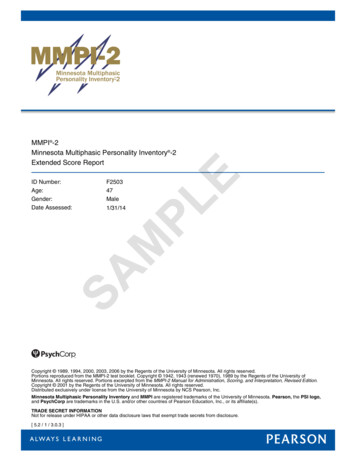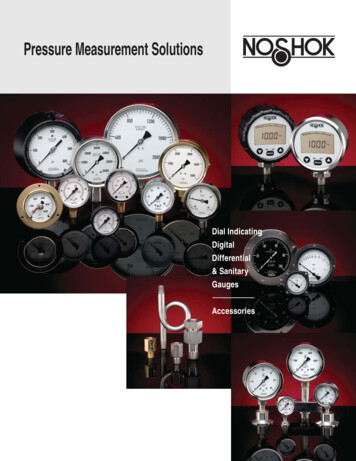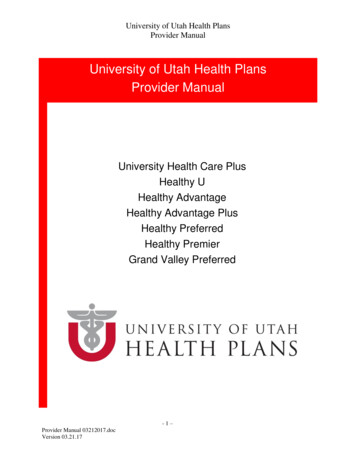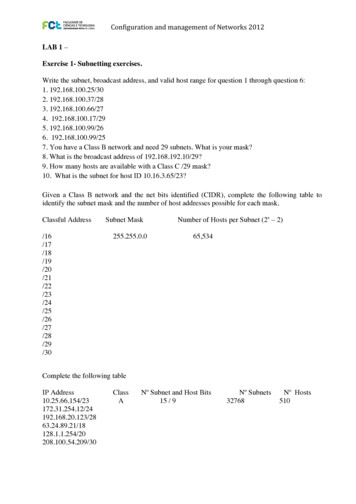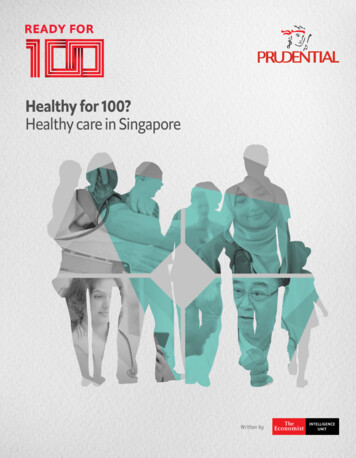
Transcription
Healthy for 100?Healthy care in SingaporeWritten by
ForewordSingapore’s healthcare system has achievedconsiderable success. The country is one of thehealthiest in the world with a population that isranked third globally for life expectancy.That is great news except that whileSingaporeans are living longer, its populationhas also begun ageing faster. The UnitedNations projects that our rate of ageing overthe next two decades will be the fastest thatany country has seen over such a period. By2030, an expected 900,000, or one in fourSingaporeans, will be over the age of 65.Recognising the health challenges thatcome with an ageing population such asrising healthcare costs, the forward-lookingSingapore government has started planningahead to ensure the country’s healthcaresystem remains accessible and affordable toits people. This is supported by the recognitionthat the health of a nation is not the soleresponsibility of policymakers. Businesses,healthcare practitioners and individuals all haveimportant roles to play.As a life insurer serving nearly a third ofthe country’s population, we have beenreflecting on our own role in the healthcareecosystem. How can we better collaboratewith stakeholders in the ecosystem to ensure The Economist Intelligence Unit Limited 2019healthcare and insurance continue to remainaffordable for future generations? At the sametime, how can we support our customers inextending their health spans, so they can livewell for longer?A critical piece of the solution is harnessingtechnology to empower individuals to takecharge of their health. It is with this in mindthat we are investing in preventative healthcaresolutions to motivate people to adopt healthylifestyle habits as well as to support the earlydetection and intervention of chronic diseases.We are also dedicated to raising awarenesson the importance of investing in one’shealth through our research programme onlongevity. This second edition of the series,Healthy for 100?, explores the opportunitiesand challenges that lie ahead for Singapore’shealthcare system as its people live longer.The insights are gleaned from interviews withover 200 healthcare practitioners in Singapore.We hope the discussions flowing from this pieceof research will help to inspire concerted actionfrom all stakeholders and pave the way for ahealthier and happier Singapore.Wilf BlackburnCEO, Prudential SingaporeHealthyHealthyfor 100?for 100?HealthyHealthycarecarein Singaporein Singapore 3
Healthy for 100? Healthy care inSingapore examines the opportunitiesand challenges that lie ahead forSingapore residents, businesses,healthcare practitioners andpolicymakers as people live longer.4 Healthy for 100? Healthy care in Singapore The Economist Intelligence Unit Limited 2019
ContentsAbout the research1Executive summary21. Introduction: The fruits of achievement3a.The transformed health challenge3b.Unease despite substantial focus on healthand healthcare42. Resident readiness: Policy for better preventiona.Limited progress7b.Looking for new ideas93. Healthcare system readiness12a.Cost12b.Integration124. Social readiness: Long-term care for older citizens16a.An expensive necessity16b.Technology is part of the solution185. Conclusion: The need to persevere The Economist Intelligence Unit Limited 2019720HealthyHealthyfor 100?for 100?HealthyHealthycarecarein Singaporein Singapore 5
About the researchHealthy for 100? Healthy care in Singaporeis an Economist Intelligence Unit reportcommissioned by Prudential Singapore. It is partof the Ready for 100 research programme, whichexamines the opportunities and challenges thatlie ahead for Singapore residents, businesses,healthcare practitioners and policymakers aspeople live longer. This report, which focuses onopportunities and challenges for Singapore’shealthcare system, is based on two strandsof research: In addition to the survey, we conducteda series of in-depth interviews withsenior government officials, businessexecutives and other experts. Our thanksare due to the following individuals (listedalphabetically by surname) for their timeand insights: In March 2018 The Economist IntelligenceUnit surveyed 203 healthcare practitionersin Singapore. It was conducted inparallel with a survey of 1,214 residentsof Singapore, the results of which arepresented and analysed in Ready for 100?Preparing for longevity in Singapore. Janice Chia, founder and managing director,Ageing Asia This report examines the results of thehealthcare practitioners’ survey. Therespondents were split evenly betweenmen and women. Twenty-five per cent werenurses, 31% were general physicians, 19%were specialist physicians and 26% weresenior management and administration.(Due to rounding, figures may not equal100%.) Forty per cent provide their servicesat polyclinics or family clinics, while 35%provide at general hospitals, 21% atcommunity hospitals and 4% at specialisthospitals or institutions. Seventy-nine percent of practitioners have patients 50 yearsold and above making up 41-100% of theirpatient population.1 Healthy for 100? Healthy care in SingaporeThe report was written by Paul Kielstra andedited by Charles Ross, with editorial supportfrom HuiQi Yow. The Economist IntelligenceUnit bears sole responsibility for its content.The findings and views expressed in thereport do not necessarily reflect the views ofthe sponsor. Angelique Chan, executive director, Centrefor Ageing Research and Education andDuke-NUS Medical School Dr Jeremy Lim, partner and head of healthand life sciences Asia Pacific, Oliver Wyman Dr Lim Wee Shiong, senior consultant,Institute of Geriatrics and Active Ageing,Tan Tock Seng Hospital Phua Tien Beng, chief executive officer,Singapore operations division of ParkwayPantai Tan Hwee-Pink, associate professor ofInformation Systems, Singapore ManagementUniversity The Economist Intelligence Unit Limited 2019
Executive summarySingapore’s population is both ageingrapidly and living longer. In 2015 11.7% ofSingaporeans were 65 or older and the UNestimates that by 2035 this will more thandouble to 26.6%. Further, life expectancy hasrisen to 83.1 years in 2017—from 76.9 in 1997.However, for people to enjoy extendedlifespans, they need well-supportedhealthspans. This requires concerted effortfrom both residents and healthcare providers. Singapore’s rapid ageing will accelerate inthe coming 15 years, shifting the country’sdisease load. In particular, a greaterproportion of people will need to manageone or more chronic diseases. Although the government has policiesto prepare for this change, surveyrespondents remain uneasy aboutwhether Singapore’s residents andother stakeholders are doing enough onprevention, the healthcare system andlong-term care. Lifestyle modifications, in order to preventmany chronic diseases, have improvedin recent years but too many people—especially younger ones—are not proactivein these areas. In addition to its existing,substantial efforts, the government maywish to consider new kinds of initiativesand ones focused on younger people.Healthcare providers should also workmore actively with individual residentson prevention. The price of long-term care is highand likely to grow increasingly beyondreach. The government is taking stepsto put in place mandatory savings andinsurance, but no simple funding panaceaexists. Greater use of in-home medicaltechnology could likely contribute to apotential solution. Addressing the rise in chronic diseaseand multi-morbidity will require shiftingattention to growing medical costs andfragmentation within the healthcaresystem. A shift toward person-centred,value-based care—where care is basedon the needs of the patient and paymentaligned to health outcomes—would go fartoward meeting both requirements. Thegovernment is moving in that direction,but the transition will be challenging. The Economist Intelligence Unit Limited 2019Healthy for 100? Healthy care in Singapore 2
Introduction: The fruits of achievementSingapore has seen substantial health systemand public health success in recent decades.Its already good average life expectancy hasnot only been growing, but has done so fasterthan that of other high-longevity countries.In 1997, for example, Singaporeans onaverage lived 76.9 years. By 2017 however,life expectancy had risen to 83.1 years. Twodecades from now, the UN projects thatthe country will have an average longevityof 86.2.1This greater life span and a long-term declinein the birth rate (which has recently stabilisedat the low level of about 1.2 births per female2)have together increased the proportion ofthe population aged 65 or over, or what thegovernment calls “the silver generation”.In 1995 just 6.4% of Singaporeans were inthis group; by 2015, it was 11.7%. The UNprojects that by 2035 this will more thandouble to 26.6%. By that year, one in 90 of thepopulation will be 90 years old or older.3The health system has, to date, coped well.Indeed, over the past decade and a half,healthy life years have risen very slightlyfaster than life expectancy itself.4Now, though, ageing in Singapore isaccelerating rapidly. In the coming decades,its speed will be “historically unprecedented”,according to Jeremy Lim, partner and headof health and life sciences, Asia Pacific, atOliver Wyman. The country’s percentage pointincrease in the population over 65 between1995 and 2015 was the 17th quickest in theworld. In the two following decades, the UNprojects it to be the fastest that any countryhas seen over such a period, and more thanthree times the global average.The transformed health challengeLim Wee Shiong, a senior consultant at theInstitute of Geriatrics and Active Ageing inTan Tock Seng Hospital, explains that thepopulation ageing occurring in Singaporeis part of a “worldwide success story and aworldwide health conundrum.” The olderpopulation is not inherently unhealthy buthas specific medical needs different fromthose Singapore has faced in the past, suchas more co-existent chronic diseases anda greater prevalence of certain diseases suchas dementia.Janice Chia, founder and managing directorat Ageing Asia, an ageing market consultancysocial enterprise, agrees: “One of the biggestchallenges facing Singapore is how we aregoing to prepare to help people living longerand therefore facing a longer duration oftime when they have chronic diseases thatneed management.”Phua Tien Beng, CEO of the Singaporeoperations division of Parkway Pantai, one ofthe country’s largest private hospital groups,adds that although Singapore engages inextensive long-term planning, ageing-relatedshifts would “add strain to the healthcareprovision of any nation”.One measure of disease burden, Years Livedwith Disability (YLD)—the average numberof years lived with a disability or any longterm medical condition—illustrates how thechronic disease challenge has already grown.The accompanying charts show the steadyrise in YLDs per 100,000 people of one of themost prevalent health issues for the ageingpopulation in Singapore—cardiovasculardisease. Between 1990 and 2016 almost a thirdmore people became afflicted, with the figurerising from 356 YLDs per 100,000 in 1990 to529 YLDs per 100,000 in 2016.Adding to the complications that thisgrowing incidence brings is the number ofolder individuals who develop more than onechronic condition—called multi-morbidity.Over half of Singapore’s residents that areolder than 60 fall into this category.5 Oftenthis involves patients with not simply twodiseases but more, adding to the complexity ofproviding care. Mr Phua explains that “if youlook at anyone above 65, they probably haveseveral chronic diseases such as diabetes,cancer, heart disease, high blood pressure, orhigh cholesterol, to name just a few.”For such individuals, appropriate care requiresnot just expertise in specific conditionsbut also in how to simultaneously treat1 All life expectancy data from UN Population Division, “World Population Prospects: The 2017 Revision, File MORT/7-1: Life expectancy at birth (both sexes combined) by region, subregion and country, 19502100 (years),” 2017 and Economist Intelligence Unit calculations.2 Fertility rate, total (births per woman), N3 All data on proportion of population over 65 from UN Population Division, “World Population Prospects: The 2017 Revision, File POP/9-1: Percentage total population (both sexes combined) by broad age group,region, subregion and country, 1950-2100,” 2017 and Economist Intelligence Unit calculations.4 Economist Intelligence Unit calculations based on UN Population Division, “World Population Prospects: The 2017 Revision, File MORT/7-1: Life expectancy at birth (both sexes combined) by region, subregionand country, 1950-2100 (years),” 2017 and World Health Organisation (Global Health Observatory), “Healthy life expectancy (HALE) Data by country,” updated 2018.5 Louisa Picco et al., “Economic burden of multimorbidity among older adults: impact on healthcare and societal costs,” BMC Health Services Research, 2016.3 Healthy for 100? Healthy care in Singapore The Economist Intelligence Unit Limited 2019
Figure 1: Living with cardiovascular diseases in SingaporeYLDs per 100,000 20142016Source: Institute for Health Metrics and Evaluation, GBD Compare Data Visualization, 2017several diseases without unintended sideeffects or drug interactions. This typicallyrequires care personalised to the individuals’specific situation.The issues are more than specifically medicalones, says Dr Lim Wee Shiong. Older peopleare at a higher risk of becoming what doctorscall “frail”, where they have fewer physical,cognitive, emotional and social resourcesto recover from health setbacks. Suchindividuals, he says, “have multiple interactingissues, including functional and social ones,which make care much more complex.” The Economist Intelligence Unit Limited 2019Accordingly, notes Ms Chia, “ageing is notjust a question of medical services but ofwhole-of-life wellness: how do you keepolder persons engaged to be motivated tostay healthier and active?” This includes,among other things, providing the growingproportion of the population reaching olderyears with appropriate levels of long-term,social care and support—whether at homeor in specialist facilities. Though not strictlya medical intervention, such care is essentialin many cases for maintaining health andoverall quality of life.Unease despite substantial focus onhealth and healthcareNeither the challenge of health in anageing society nor its complexity is lost onSingapore’s government. In 2016 policymakersset out three key shifts to the healthsystem that they wished to see: from anemphasis on healthcare to one on health;from hospital provision to community-basedcare; and from a focus on quality to oneon value. Similarly, its multi-year, S 3bnAction Plan for Successful Ageing includesamong its priority areas health and wellness,Healthy for 100? Healthy care in Singapore 4
Figure 2: Ready for 100?Please indicate your response per age group to the following statement: Singaporeans are ready from a health and wellness perspective to live to 100.(% respondents, excludes “don’t know” responses as these are 2% or less of the total respondents)Adults aged 25 – 454%Adults aged 46 – 653%Adults aged 65 5%My self5%36%16%10%33%Strongly e11%13%21%18%Strongly agreeSource: The Economist Intelligence Unit.Note: Due to rounding, figures may not equal 100%.healthcare, and aged care, with variouspolicies to enhance each.6Nevertheless, warns Dr Jeremy Lim, nostraightforward roadmap exists for reshapingthe multiple elements needed for healthyageing as quickly as Singapore must do.“Healthcare policymakers, I suspect, are notfamiliar or comfortable with the challenge,which will require a lot of iteration andexperimentation,” he says.It is no surprise, given the difficulty of thistransition, that Singapore’s residents remainwary about what health and healthcare in afuture with extended lifespans holds.In an Economist Intelligence Unit surveyof more than 200 clinicians and healthcareproviders, only about half of respondentsagree that, from a health and wellnessperspective, the country’s residents are readyto live to 100.Residents themselves are more concerned:55% of those taking part in a separate generalsurvey, also conducted by The EconomistIntelligence Unit, admitted that theypersonally are not ready from a health andwellness perspective to reach that age.6 Ministry of Health, Action Plan for Successful Ageing, 2016.5 Healthy for 100? Healthy care in Singapore The Economist Intelligence Unit Limited 2019
Singapore has seen substantialhealth system and public healthsuccess in recent decades. The Economist Intelligence Unit Limited 2019Healthy for 100? Healthy care in Singapore 6
Resident readiness: Policy for better preventionLimited progressIn the view of Tan Hwee-Pink, associateprofessor of Information Systems at SingaporeManagement University, the main healthcarechallenge from population ageing “will bepreventive self-care—taking matters into yourown hands to prevent or prolong the onsetof chronic conditions”. Dr Lim Wee Shiongagrees, “the focus on disease preventioncannot be overemphasised—it is extremelycritical from a long-term perspective.Good health when one is old doesnot happen by chance but is the consequenceof preparation.”Ultimately, individuals need to play the mainrole in their own health. Seventy per centin our survey of clinicians and healthcareproviders agree that residents are responsiblefor supporting their own healthy ageing.Dr Lim Wee Shiong speaks for severalinterviewees when he says that, in an ageingsociety, “what cannot be denied is that I needto take ownership of my own health. It is not,in the end, my government’s problem”.Rarely in the world does this happenspontaneouslywithoutencouragementthough, and Singapore is no stranger togovernment support of individuals adoptinghealthy lifestyles. School-based healtheducation, for example, dates back nearlya century to the colonial era and state antismoking campaigns to the mid-1980s. Since2001 the Health Promotion Board within theMinistry of Health has driven a wide range ofprevention programmes for people of all ages.The government has stepped up efforts aroundthe prevention challenges associated withpopulation ageing, including healthy livingelements of the Action Plan for SuccessfulAgeing. Dr Jeremy Lim notes that the countrynow has “government-sponsored or supportedsenior activity centres to keep older peoplephysically, mentally and socially active.”A particularly high-profile effort has beenthe the health ministry’s “War on Diabetes,”launched in 2016, which includes the “Eat,Drink, Shop Healthy Campaign” aimed atindividual residents as well as grants todining establishments to develop better mealoptions, working with beverage manufacturersto reduce the level of sugar in their products,and the S 20 million three-year HealthierIngredients Scheme to encourage foodproducers to develop better products. Thegovernment is now considering banning ortaxing the sale of certain high sugar drinks7.Such efforts are having an effect, saysAngelique Chan, executive director at theCentre for Ageing Research and Education andDuke-NUS Medical School. In her experience,“Singaporeans have become very alert todisease prevention, especially in the last fiveyears. More people are running than everbefore. They are choosing healthier foodoptions and counting calories.”However, survey results indicate that despitesuch progress, the picture of healthy livingamong Singaporeans remains ambiguous.According to those in our survey of healthcareproviders, individual prevention efforts arecommon but far from universal. Between 27%Figure 3: Getting wiser with ageDo you believe that Singaporeans in the following age groups are proactive about preventing these key agerelated diseases? (% respondents answering “very proactive” or “fully proactive”, 4 or 5 on a scale of 1 to 5)DementiaHeart 43%45-6549%65%59%66%63%65 59%65%72%69%66%Source: The Economist Intelligence Unit7 Sugar tax to change behaviour, not boost revenues r-tax-to-change-behaviour-not-boost-revenues7 Healthy for 100? Healthy care in Singapore The Economist Intelligence Unit Limited 2019
and 72% of respondents believe that—dependingon age group and the disease in question—Singaporeans are very or fully proactive onprevention. (One caveat is that these figuresmay be too optimistic, resulting from clinicianslistening to what patients tell them rather thanfully knowing how they behave.)Taken at face value, the responses highlight twopotential areas where progress is needed. First,even among older Singaporeans, a significantminority needs to become more engaged inprevention. “There is a knowledge-practicegap,” says Dr Lim Wee Shiong. “People knowwhat they need to do, but they don’t do it.”improvements, “young Singaporeans are notvery active in disease prevention. They do notthink about ever being disabled or ill.”A more worrying issue is the lack of such effortamong those younger than 45, where underhalf are perceived to be very or fully proactivefor every condition covered in the survey.These results do not surprise Mr Phua, who says“it is extremely difficult to communicate tosomeone who is 30 today the risks of disabilitylater in life.” Dr Chan agrees. Even after recentRespondents in the general population surveyfurther reflect a disconnect between aspirationand reality, reporting that their main strategiesfor disease prevention are healthy eating (citedby 68%) and physical activity (46%). However,each day, 73% of those surveyed consume atleast one serving of sweets, cakes or similar;61% at least one salty snack; and 69% atFigure 4: Strategic planningWhich of the following strategies could best help Singapore prepare for the future demands of the ageing population? (% respondents, excludes “did notanswer” responses)51%Containment of rising costs42%Greater physician emphasis on disease prevention/healthy lifestyles41%More support for caregivers39%Better integration between professionals, facilities, patients and support systems34%Expansion of hospital and clinical care facilities29%Faster adoption of new diagnostic and therapeutic technologiesBetter utilisation of big data analytics and artificial intelligence (AI)21%Increase in number of doctors20%Increase in number of nurses20%Source: The Economist Intelligence Unit8 The WHO recommends that adults do at least 150 minutes of moderate-intensity aerobic physical activity throughout the week. In our survey, only 12% said that they exercised for 20 minutes or more every day. The Economist Intelligence Unit Limited 2019Healthy for 100? Healthy care in Singapore 8
least one sugary drink. Meanwhile, only 12%report getting the World Health Organisationrecommended level of exercise.8Looking for new ideasDr Chan adds that officials are discussinghaving healthy living programmes—currentlyfocused on people in their 50s—that includeyounger generations. The hope is to create a“cradle to grave” approach to prevention.Mr Tan warns, though, that more of the samein the area of prevention may be insufficientfor this age group: “Despite various campaignson reducing sugar intake, cutting down onsmoking, drinking more water, and keepingan active and healthy lifestyle, obesity isincreasing among our kids.” His concern is that“Singapore’s healthcare system tends to go fortried and tested approaches.”He suggests that it should consider somethingbolder, such as copying private insurers andencouraging active lifestyles by, possibly,allowing people to buy fitness devices usingmoney in mandatory Medisave accounts, orcrediting those accounts if people do a certainlevel of exercise daily.The respondents in our survey of healthcareproviders agree. For example, 84% say that, toprepare for the ageing population, Singapore’shealth system should place greater emphasison preventative care. Similarly, when askedwhich health strategies would best helpSingapore prepare for ageing, a greaterphysician emphasis on disease prevention andhealthy lifestyles was amongst the top threechoices (42%).This involves working with doctors and thepatients themselves, including sharinginformation that providers might havepreviously considered their own. ParkwayPantai, for example, is creating a digitalhealth platform so that patients can see all oftheir relevant health information in one placeand “make informed decisions to preventdiseases”, says Mr Phua.The survey data further back up the perceivedneed for such co-prevention: 79% say thatpatients should visit their physicians to set uppreventative care plans compared with only10% who say patients should only visit theirphysicians to diagnose and treat disease.The healthcare system also has a major role toplay. Mr Phua explains that “in the healthcarebusiness, the goal is to make everyoneconcerned about their own health.”9 Healthy for 100? Healthy care in Singapore The Economist Intelligence Unit Limited 2019
The hope is to createa “cradle to grave”approach to prevention. The Economist Intelligence Unit Limited 2019Healthy for 100? Healthy care in Singapore 10
Ultimately, individualsneed to play the mainrole in their own health.11 Healthy for 100? Healthy care in Singapore The Economist Intelligence Unit Limited 2019
Health system readinessAs noted earlier, Singapore’s rapidlyincreasing longevity indicates that the healthsystem has numerous strengths. As Dr Chanputs it, “the healthcare system is very good.We Singaporeans are lucky in that sense.”Nevertheless, the acceleration of ageingpresents a bigger health system challenge thanin the past—one which survey respondentsbelieve necessitates reform: 83% agree thatthe higher volume of older patients in the nearfuture will require change in how medicine ispractised. Accordingly, 71% of respondents’organisations are already looking at strategiesto improve patient care for the elderly.On the other hand, he warns that the issuecan be overblown from the perspective ofthe patient, though not the government’s.A combination of mandatory savings intoMedisave accounts and enrolment intoMedishield Life insurance for high-costinterventions covers much of the expenseof outpatient and hospital care, especiallyfor individuals willing to stay in wardsrather than private rooms while inpatients.Moreover, for older residents, age-basedsubsidies and grants greatly reduce MedishieldLife premiums.IntegrationAs such, the government is sufficientlyconcerned to be taking policy initiativesThe second biggest concern of providers in oursurvey is the health system’s ability to copeto address rising costs. One was makingMedishield Life mandatory in 2015 (theprogramme it replaced had been optional).In the 2018 recent budget, the governmentalso announced measures to crack downon those who do not pay their Medishieldpremiums and to require private insurers,as of 2021, to include at least a 5% co-pay inany supplementary coverage policies so thatSingaporeans would be more careful of costwhen making healthcare choices.9Among respondents, the two overarching, andconnected, areas requiring attention are costand fragmentation of treatment.Figure 5: Paying the billCostFrom a financial perspective, how ready are Singaporeans to cover the costs of medical care needed to liveto 100? (% respondents, excludes “don’t know” responses as these are 2% or less of the total respondents)Nearly half of survey respondents (49%)say that Singaporeans are, to some degree,unprepared for the health-related expenses ofliving to 100. Not surprisingly, the healthcarestrategy that they named as most likely to helpSingapore prepare for an ageing populationis not new technology or specific medicalinterventions, but simply containment ofrising costs (51%).Dr Jeremy Lim explains that this is “a verylegitimate concern. Singapore, like the restof the world, has seen healthcare inflation faroutpace general inflation.”15%8%Very preparedSomewhat prepared34%42%Somewhat unpreparedUnpreparedSource: The Economist Intelligence UnitNote: Due to rounding, figures may not equal 100%.9 “Massive increase in premium rates for Medishield rider – SGs liable to be arrested for not paying premiums,” The Online Citizen, 26 March 2018. The Economist Intelligence Unit Limited 2019Healthy for 100? Healthy care in Singapore 12
with age-related disease (42%). A large partof the problem is structural, Dr Chan notes.“Traditionally the healthcare system hascentred around provision of acute care, andwe have become excellent in that.” However,she adds, care for chronic conditions requiresdifferent approaches.As a result, 39% of respondents identifybetter integration of care around the patientas a key strategy to prepare for ageing.Almost as many cited improved prevention(42%) and better caregiver support (41%).Eighty-one per cent say multi-morbiditywill drive a need for greater integrationamong medical specialties but only 64%of health providers surveyed currentlythink they work for well-integratedorganisations.A key part of the necessary integration,explains Dr Chan, is for Singapore’s publicsystem to move from a still relativelyfragmented primary care system to one wheregeneral practitioners can take care of patientsover their life course.Dr Lim Wee Shiong agrees, saying that thereneeds to be “an emphasis on primary care asthe cornerstone of our healthcare system.Increasingly, as you talk about an ageingpopulation with multiple comorbidities,you need to go back to the basics of primarycare, with a physician who knows the personand their family, as well as understands theirunderlying psycho-social needs.”T
The Economist Intelligence Unit Limited 2019 Healthy for 100? Healthy care in Singapore 5 About the research
